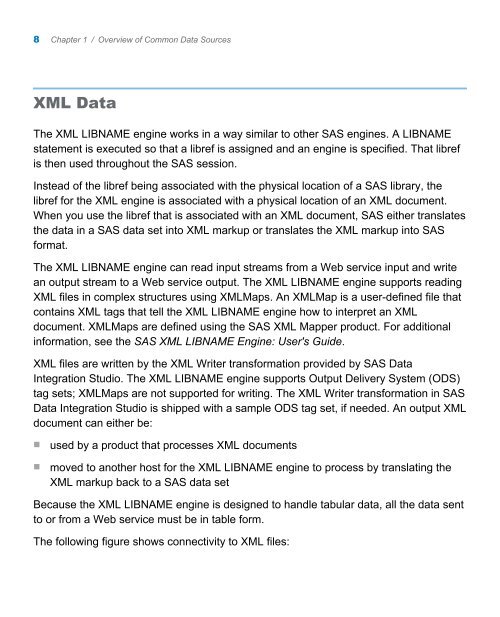SAS 9.3 Intelligence Platform: Data Administration Guide, Second ...
SAS 9.3 Intelligence Platform: Data Administration Guide, Second ...
SAS 9.3 Intelligence Platform: Data Administration Guide, Second ...
Create successful ePaper yourself
Turn your PDF publications into a flip-book with our unique Google optimized e-Paper software.
8 Chapter 1 / Overview of Common <strong>Data</strong> Sources<br />
XML <strong>Data</strong><br />
The XML LIBNAME engine works in a way similar to other <strong>SAS</strong> engines. A LIBNAME<br />
statement is executed so that a libref is assigned and an engine is specified. That libref<br />
is then used throughout the <strong>SAS</strong> session.<br />
Instead of the libref being associated with the physical location of a <strong>SAS</strong> library, the<br />
libref for the XML engine is associated with a physical location of an XML document.<br />
When you use the libref that is associated with an XML document, <strong>SAS</strong> either translates<br />
the data in a <strong>SAS</strong> data set into XML markup or translates the XML markup into <strong>SAS</strong><br />
format.<br />
The XML LIBNAME engine can read input streams from a Web service input and write<br />
an output stream to a Web service output. The XML LIBNAME engine supports reading<br />
XML files in complex structures using XMLMaps. An XMLMap is a user-defined file that<br />
contains XML tags that tell the XML LIBNAME engine how to interpret an XML<br />
document. XMLMaps are defined using the <strong>SAS</strong> XML Mapper product. For additional<br />
information, see the <strong>SAS</strong> XML LIBNAME Engine: User's <strong>Guide</strong>.<br />
XML files are written by the XML Writer transformation provided by <strong>SAS</strong> <strong>Data</strong><br />
Integration Studio. The XML LIBNAME engine supports Output Delivery System (ODS)<br />
tag sets; XMLMaps are not supported for writing. The XML Writer transformation in <strong>SAS</strong><br />
<strong>Data</strong> Integration Studio is shipped with a sample ODS tag set, if needed. An output XML<br />
document can either be:<br />
n used by a product that processes XML documents<br />
n moved to another host for the XML LIBNAME engine to process by translating the<br />
XML markup back to a <strong>SAS</strong> data set<br />
Because the XML LIBNAME engine is designed to handle tabular data, all the data sent<br />
to or from a Web service must be in table form.<br />
The following figure shows connectivity to XML files:

















